Arizona’s arid landscapes and warm climate provide the perfect environment for a wide variety of insects, including several that sting. While many species are harmless pollinators, others are equipped with potent venom and defensive behavior that can cause serious discomfort or allergic reactions. Knowing which ones to avoid is essential for safe outdoor activities.
From the aggressive Africanized honey bee to the formidable tarantula hawk, Arizona hosts some of the most painful stingers in North America. Each species has unique identifying traits, behaviors, and preferred habitats that make them easier to spot—and avoid—once you know what to look for.
This detailed guide introduces 18 of the most dangerous stinging insects found in Arizona, complete with identification tips, behavior profiles, and habitat information. It’s designed to help you stay informed, cautious, and confident while exploring the deserts, canyons, and backyards of the Southwest.
Types of Dangerous Stinging Insects Found in Arizona
Africanized Honey Bee (Killer Bee)
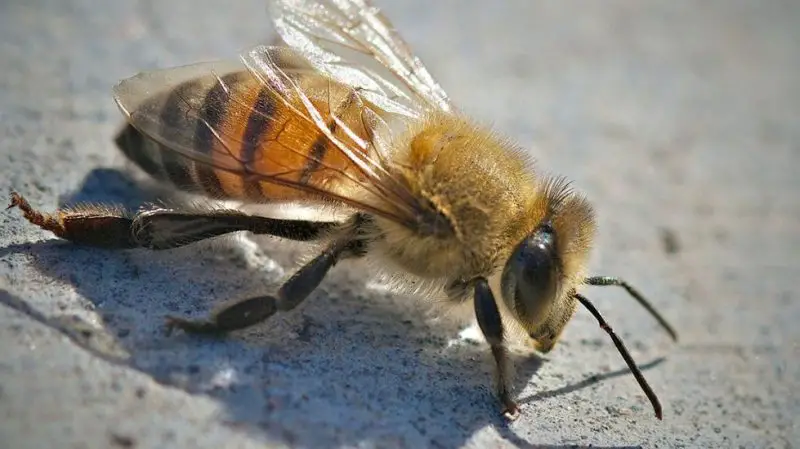
Africanized honey bees, commonly called “killer bees,” are small to medium-sized insects measuring about ½ inch long, with golden-brown bodies covered in fine hair and alternating dark stripes. They appear nearly identical to regular honey bees, making them difficult to identify by sight alone. The main difference lies in their behavior — Africanized honey bees are far more defensive and attack aggressively when their hive is threatened.
These bees typically live in large colonies that can swarm suddenly if disturbed. They are highly territorial and will pursue intruders for several hundred feet, delivering multiple stings. Each sting injects venom containing melittin and other compounds that cause sharp, burning pain, redness, and swelling. While the venom itself is not more potent than that of common honey bees, the danger arises from the number of stings received in a single attack.
Their nesting sites include tree cavities, old tires, irrigation boxes, and the walls or roofs of buildings. They thrive in Arizona’s arid desert climate, particularly in southern and central regions where temperatures remain warm year-round. Africanized honey bees are most active in spring and summer when nectar sources are abundant.
In terms of threat, these bees are responsible for more stinging incidents than any other bee species in Arizona. People allergic to bee venom face serious risks, including anaphylaxis. If you encounter a buzzing swarm or hive, avoid making noise or rapid movements, and slowly retreat to safety — disturbing them can provoke a dangerous mass attack.
Paper Wasps
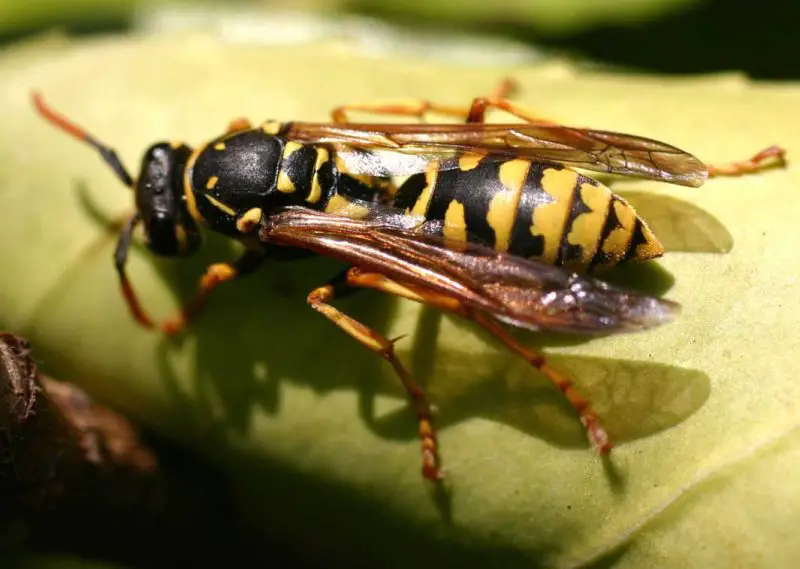
Paper wasps are slender insects about ¾ to 1 inch long, with narrow waists, long dangling legs, and smooth bodies colored in shades of black, brown, or reddish-brown, often with yellow bands. They are easily recognized by their umbrella-shaped nests made from a papery material created by mixing chewed plant fibers with saliva. These nests are typically found under eaves, porch ceilings, and ledges around homes in Arizona.
Paper wasps are generally non-aggressive but will sting repeatedly if their nest is disturbed. Their sting is extremely painful and described as a sharp, burning sensation that can last several minutes. The venom contains enzymes that cause localized swelling, itching, and redness. Some individuals may experience allergic reactions such as hives, difficulty breathing, or anaphylaxis after being stung.
These wasps are beneficial predators that feed on caterpillars and other insects, helping to control garden pests. They are most active during the warmer months, especially from late spring through early fall. Their behavior becomes more defensive during nesting season when protecting larvae.
Paper wasps prefer habitats near human dwellings or vegetation where food sources are plentiful. In Arizona’s desert climate, they often seek shaded or sheltered areas to build nests, including shrubs, cacti, and roof overhangs. Avoid approaching visible nests, as even slight vibrations or movement can trigger defensive behavior.
Yellowjackets
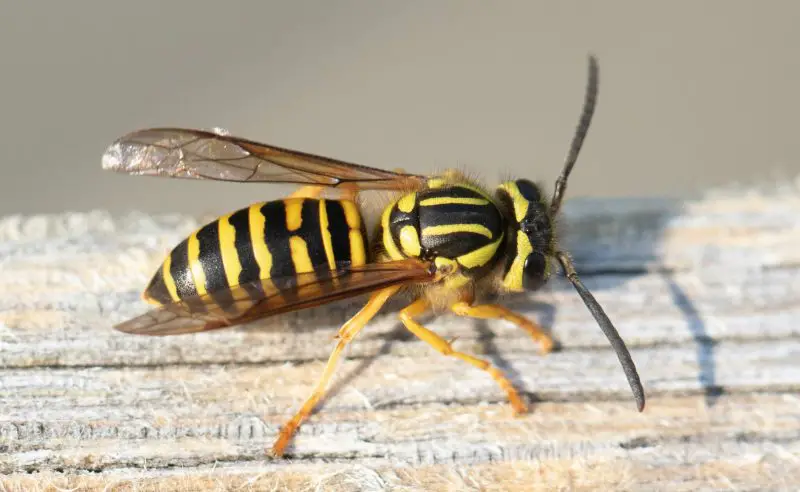
Yellowjackets are stocky, fast-moving wasps about ½ inch long, easily identified by their shiny black and bright yellow bands and smooth, hairless bodies. Unlike honey bees, they have shorter wings and a more compact build, allowing them to move quickly and sting multiple times. Their behavior is highly aggressive, especially near their nests, which are often hidden underground or within wall voids.
A yellowjacket’s sting injects venom rich in acetylcholine and kinins, producing intense burning pain followed by redness, swelling, and itching. Multiple stings can cause severe inflammation or systemic allergic reactions. Individuals allergic to wasp venom can develop anaphylaxis within minutes, requiring emergency treatment. Yellowjackets can sting repeatedly because their stinger remains intact after use.
These wasps are omnivorous and are drawn to protein- and sugar-rich foods, such as meats, fruits, and soft drinks. In Arizona, they are common around picnic areas, garbage bins, and outdoor eating spaces during late summer and fall when natural food becomes scarce. Their scavenging behavior often brings them into close contact with humans, increasing sting risks.
Yellowjackets nest in underground burrows, decayed logs, or wall cavities. Arizona’s warm climate supports their activity nearly year-round, though their peak season is from August through October. Because of their aggressiveness, any suspected nest should be handled only by trained pest control professionals.
Tarantula Hawks
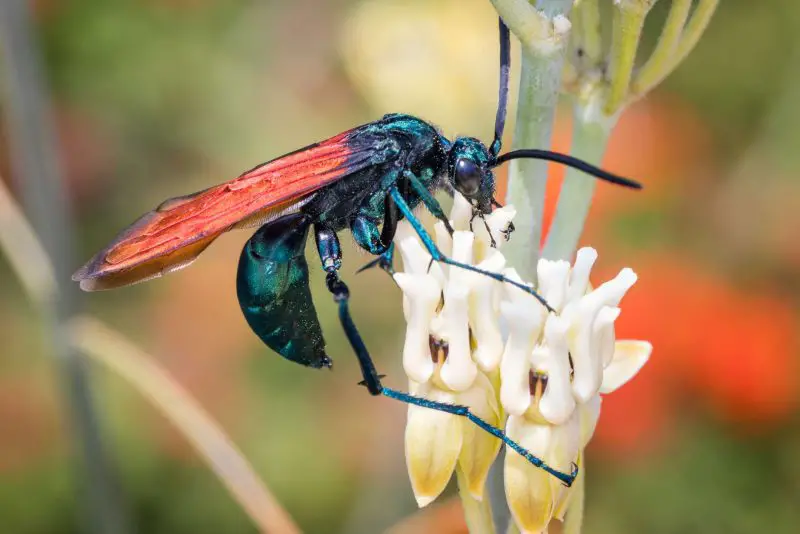
Tarantula hawks are among the largest wasps in Arizona, reaching up to 2 inches long. They are easily identified by their iridescent blue-black bodies and striking orange wings. Their long legs, equipped with hooked claws, allow them to grapple with large prey. Females possess a formidable stinger, nearly ¼ inch long, capable of delivering one of the most painful stings known to humans.
Their sting injects a neurotoxic venom designed to paralyze tarantulas rather than kill them. Although excruciating, the sting is not medically dangerous to humans, and the pain usually subsides within 5–10 minutes. The venom causes sharp, electric pain and temporary numbness but rarely results in lasting injury. Because of their painful defense mechanism, most predators avoid them entirely.
Female tarantula hawks use their venom to immobilize tarantulas, then drag them into burrows where they lay an egg on the spider’s abdomen. When the larva hatches, it feeds on the still-living tarantula. Adult wasps, however, feed exclusively on flower nectar, especially from milkweed, mesquite, and desert marigold.
These wasps inhabit Arizona’s deserts, grasslands, and scrublands, especially the Sonoran Desert. They are most active during the daytime in summer months when temperatures soar. Although intimidating in appearance, tarantula hawks rarely sting unless handled or trapped — they prefer to avoid human contact.
Velvet Ant (Cow Killer Ant)
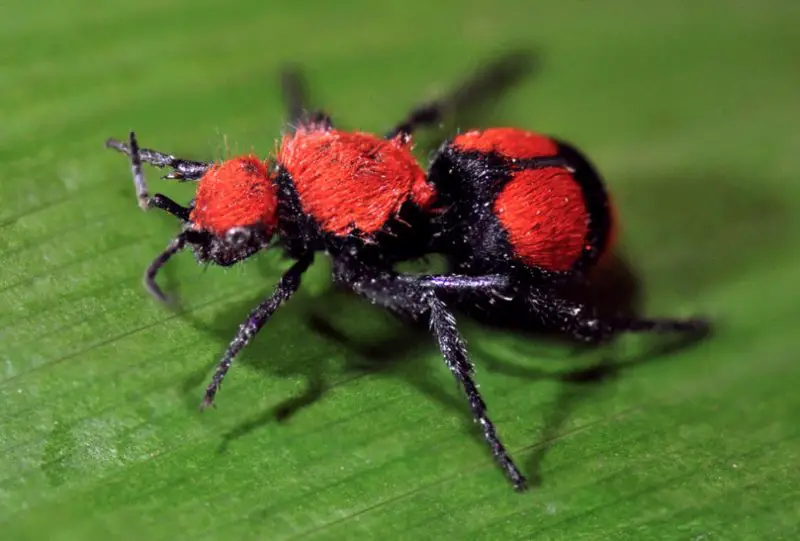
The velvet ant, nicknamed the “cow killer,” is actually a wingless female wasp known for her bright coloration and powerful sting. Females are about ¾ inch long and covered in dense, velvety hairs that are bright red or orange with black bands. This vivid appearance serves as a warning to predators of their potent venom. Males, in contrast, have wings and cannot sting.
The sting of a velvet ant is intensely painful, described as a searing, electric shock that can last several minutes. The venom contains potent alkaloids and enzymes that cause immediate burning and swelling, though it is not typically life-threatening. Because velvet ants are solitary and do not defend nests, they sting only when directly handled or pressed against the skin.
Velvet ants have a parasitic lifestyle. Female wasps infiltrate the nests of ground-nesting bees or other wasps, laying their eggs inside. When the larvae hatch, they consume the host’s developing offspring. This behavior helps control populations of other stinging insects in the ecosystem.
They are widespread throughout Arizona’s desert regions, especially in sandy soils, dry grasslands, and open scrub habitats. Most sightings occur during summer when temperatures are high. Their bright colors make them easy to spot crawling across the ground — but touching one is a painful mistake few repeat twice.
Harvester Ants
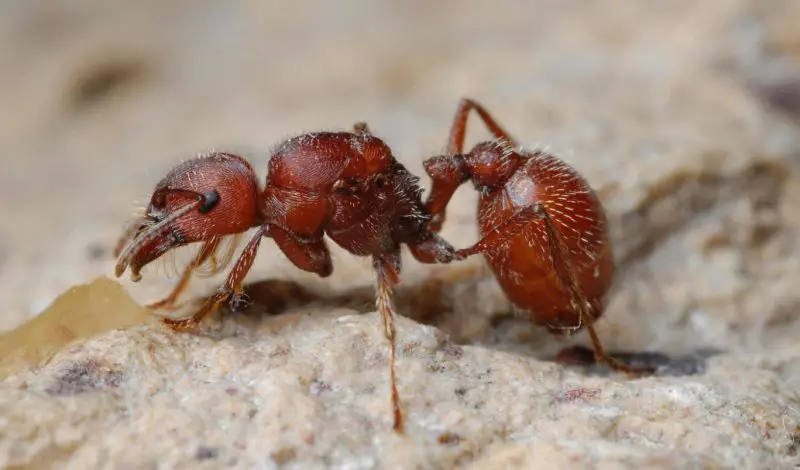
Harvester ants are medium-sized ants, typically ¼ to ½ inch long, with reddish-orange or rusty-brown bodies and large heads. They are easily recognized by their clean, circular nest entrances surrounded by bare soil, as the ants remove all vegetation around their mounds. These nests can stretch several feet underground and are often visible as dome-shaped mounds scattered across Arizona’s dry plains and desert scrublands.
Although not inherently aggressive, harvester ants are highly defensive of their nests and will attack in numbers if disturbed. Their sting is extremely painful and ranks among the most potent of any North American ant species. The venom contains alkaloids that produce intense burning pain, followed by redness, swelling, and itching. In some individuals, the reaction can escalate to nausea, dizziness, or even allergic shock.
Each sting leaves a raised welt that may last several days and is slow to heal. Because their stinger remains intact, they can sting multiple times in rapid succession. It’s best to avoid walking barefoot near ant mounds, as even minor vibrations can trigger a defensive response from the colony.
Harvester ants play an important ecological role by collecting seeds and storing them underground, which aids in soil aeration and plant dispersal. They thrive in Arizona’s arid and semi-arid regions, especially in open fields, grasslands, and desert valleys. They are most active during warm daylight hours, particularly in the summer months.
Scorpions (Arizona Bark Scorpion)
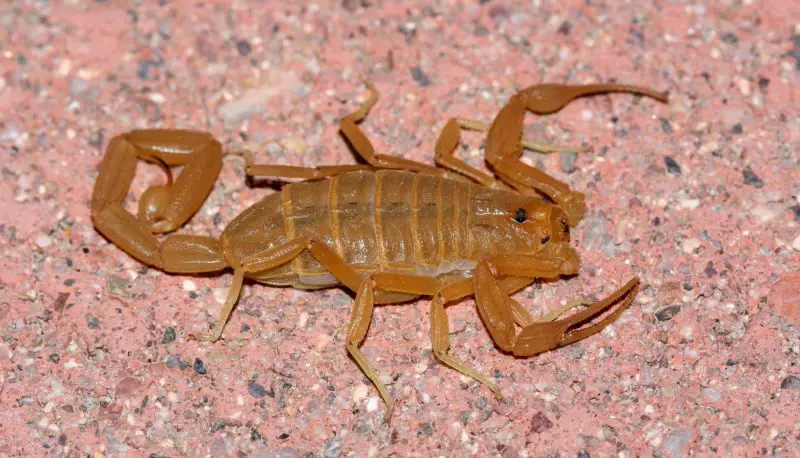
The Arizona bark scorpion (Centruroides sculpturatus) is one of the most infamous venomous creatures in the state. Measuring 2.5 to 3 inches long, it has a slender body and a distinctively thin tail tipped with a sharp stinger. Its pale yellow to tan coloration allows it to blend seamlessly with desert sand and rocks. This nocturnal arachnid is easily identified by its ability to glow bright blue-green under ultraviolet light.
The sting of an Arizona bark scorpion is highly toxic, containing neurotoxic venom that causes intense pain, tingling, numbness, and muscle spasms. In rare cases—especially in children, the elderly, or those allergic to venom—it can cause breathing difficulties and require emergency medical treatment. The pain from a sting can persist for several hours, followed by lingering sensitivity.
Bark scorpions are typically non-aggressive and sting only when threatened or accidentally trapped against the skin. They often enter homes seeking moisture or shelter, hiding under rocks, logs, shoes, or in bedding. Their flattened bodies allow them to slip through cracks as thin as a credit card.
These scorpions are widespread in central and southern Arizona, particularly in and around Phoenix, Tucson, and the Sonoran Desert. They prefer cool, shaded areas during the day and emerge at night to hunt insects and small arthropods. Pest control and sealing home entry points are essential preventive measures in infested regions.
Cicada Killer Wasps
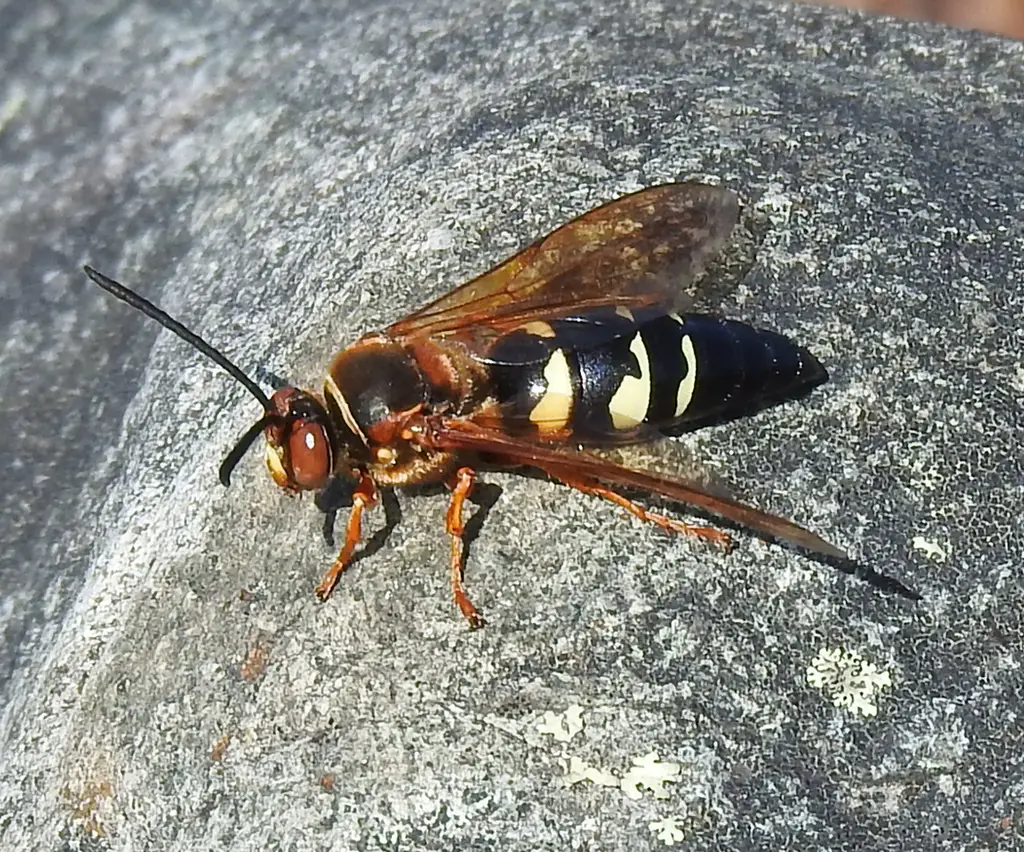
Cicada killer wasps (Sphecius speciosus) are among the largest wasps found in Arizona, reaching lengths of up to 2 inches. They are striking in appearance, with black bodies adorned with yellow bands, reddish-brown wings, and large heads with powerful mandibles. Despite their formidable size, these wasps are generally docile and rarely sting humans unless handled or trapped.
Female cicada killers possess a strong stinger used primarily for paralyzing cicadas, their preferred prey. The sting injects venom that immobilizes the insect without killing it, allowing the female to drag the cicada into an underground burrow to serve as food for her larvae. For humans, the sting is painful but not medically serious, causing brief burning and swelling. Males, though territorial and prone to hovering near intruders, cannot sting at all.
Their burrows are often seen as small mounds of soil with a single entry hole in sandy or loose soil. They prefer sunny, open areas such as lawns, playgrounds, golf courses, and dry fields. In Arizona, these wasps are active during midsummer when cicada populations peak.
Cicada killers play a valuable ecological role by keeping cicada populations under control. They thrive in desert edges and semi-urban environments with dry, well-drained soil. While their size can be intimidating, their behavior is not aggressive, making them more of a curiosity than a danger.
Bumblebees
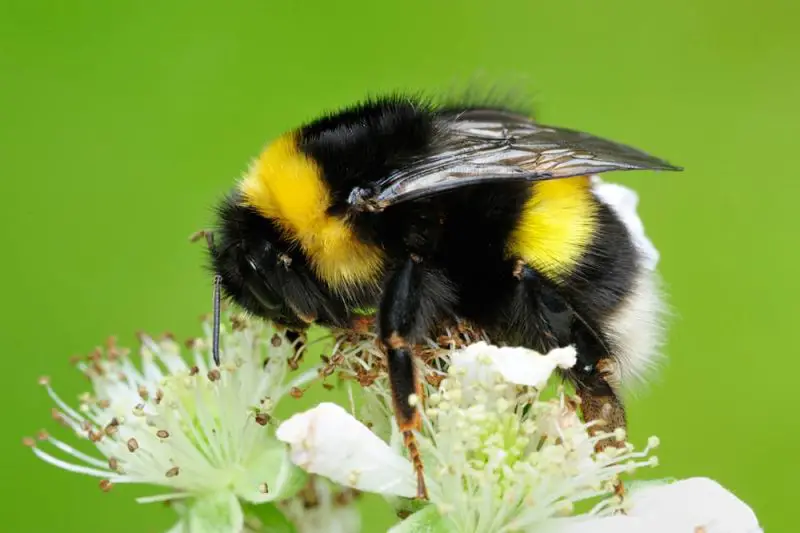
Bumblebees are large, fuzzy bees ranging from ½ to 1 inch in length, recognized by their black-and-yellow striped bodies and soft, hairy texture. Their thick coats of hair help them survive cooler temperatures compared to other bees, making them more common at higher elevations in Arizona, such as Flagstaff and Prescott. They are vital pollinators for both wildflowers and agricultural crops.
Although bumblebees are not aggressive by nature, they will defend their nests vigorously if disturbed. Their stinger lacks barbs, allowing them to sting multiple times. A bumblebee sting injects venom that causes immediate, sharp pain, redness, and localized swelling. For individuals with bee allergies, even one sting can cause anaphylactic shock and requires urgent medical attention.
Their nests are often found in abandoned rodent burrows, compost piles, or gaps within walls and sheds. Bumblebees prefer habitats rich in flowering plants and moisture, making gardens, meadows, and forest edges ideal nesting areas. They are active from spring through fall, with colonies reaching their peak in late summer.
Bumblebees are highly social insects that live in small colonies, each with a single queen. Their docile nature and critical role in pollination make them an essential part of Arizona’s ecosystem. Observing them from a safe distance ensures both safety and preservation of their vital environmental contributions.
Carpenter Bees
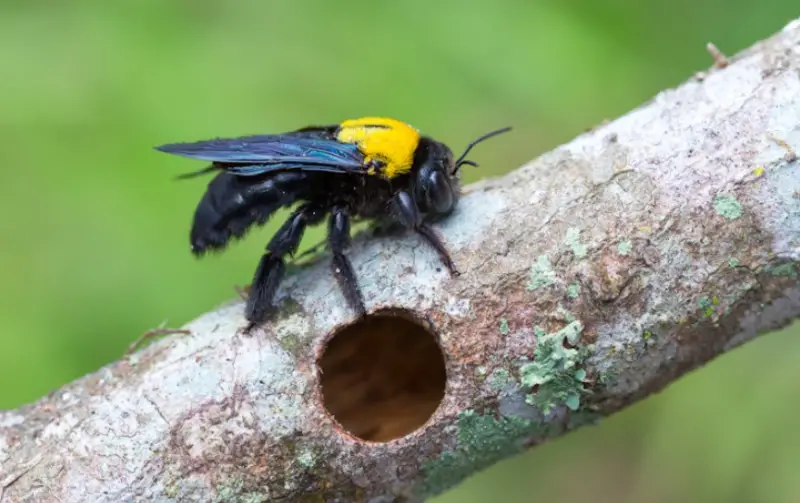
Carpenter bees are robust insects about 1 inch long, closely resembling bumblebees but with shiny, hairless black abdomens instead of fuzzy ones. They are often mistaken for bumblebees due to their size and buzzing flight pattern. Males can be easily identified by a small white or yellow patch on their face and their tendency to hover near intruders, while females are the ones capable of stinging.
The sting of a carpenter bee is painful but generally mild, causing temporary redness and swelling. Females sting only when directly handled or provoked. Males, though territorial and aggressive in behavior, cannot sting. Carpenter bees’ primary threat lies not in their sting but in their nesting habits, which can cause structural damage to wood over time.
These bees bore perfectly round holes about ½ inch wide into wood surfaces to create nesting tunnels. Over several years, repeated tunneling can weaken wooden decks, fences, and roof eaves. The bees prefer untreated or weathered wood, often targeting cedar, pine, and redwood structures.
In Arizona, carpenter bees are common statewide, particularly in suburban and desert environments where wooden structures and mesquite trees are abundant. They are solitary bees, active from spring through early fall, and play an important role in pollination despite their destructive nesting behavior. To prevent damage, painting or sealing exposed wood surfaces can deter them from nesting.
Hornets (European Hornet)
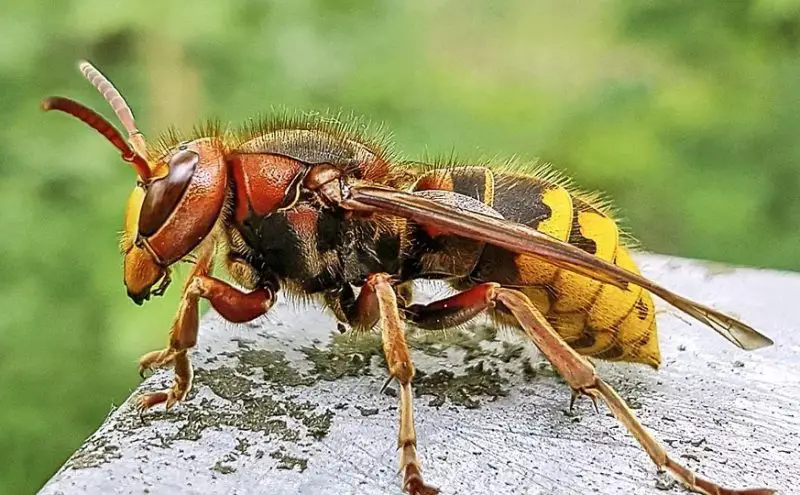
The European hornet (Vespa crabro) is a large wasp species measuring about 1 to 1.5 inches in length. It has a reddish-brown body with yellow abdominal stripes and translucent orange wings. Although more common in the eastern United States, European hornets are occasionally found in parts of Arizona, especially in higher elevations and suburban areas with abundant trees and vegetation. Their size and loud buzzing make them easily noticeable when flying near human dwellings.
These hornets are highly defensive of their nests and can sting multiple times without losing their stingers. Their venom contains acetylcholine and histamines that cause intense, throbbing pain, redness, and swelling. For sensitive individuals, the venom may induce allergic reactions or even anaphylactic shock. Unlike honey bees, European hornets are capable of attacking in coordinated groups when their nest is threatened, making them particularly dangerous to disturb.
They are nocturnal hunters, preying on insects such as grasshoppers, flies, and other wasps. European hornets often nest in hollow trees, wall voids, or attics, creating large papery colonies that can house hundreds of individuals. Their activity peaks during late summer and early fall when colony size reaches its maximum.
In Arizona, sightings occur mainly in forested or suburban areas with shade and moisture. During summer, residents should avoid approaching visible nests or hornet flight paths, as even minor vibrations can trigger aggressive defense behavior. Professional removal is strongly recommended if a nest is discovered near living areas.
Mud Dauber Wasps
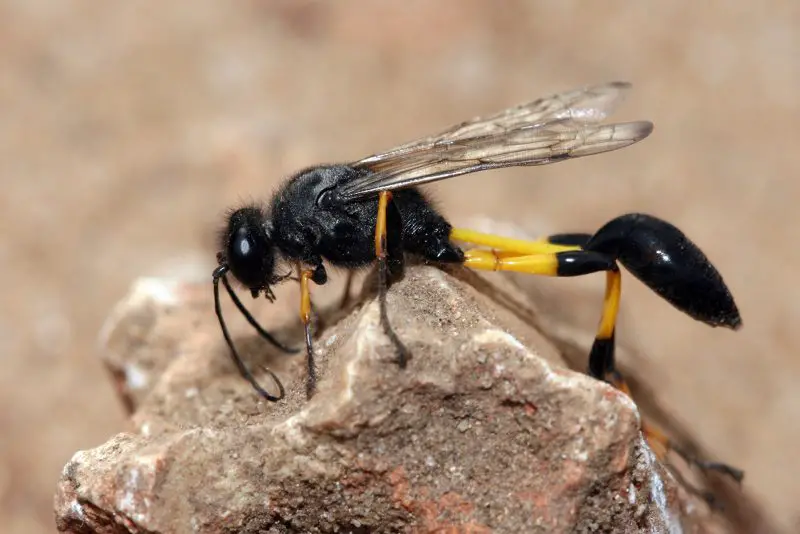
Mud dauber wasps are slender, solitary wasps ranging from ½ to 1 inch long, with shiny black, metallic blue, or steel-gray bodies and long, thread-like waists. They are commonly recognized by their behavior of carrying mud to construct small tubular nests on walls, eaves, and ceilings. Each nest consists of several mud cells, each containing a single paralyzed spider for the developing larva.
Unlike many other wasps, mud daubers are not aggressive and rarely sting unless directly handled. Their sting, while painful, is mild and short-lived, causing only temporary redness or swelling. Because they do not defend their nests, they are considered beneficial insects. Their venom is designed to paralyze spiders, not for self-defense, making them far less threatening to humans than paper wasps or hornets.
Mud daubers are natural pest controllers, preying on spiders such as orb-weavers and black widows. They use their venom to immobilize spiders, sealing them inside mud chambers as food for their offspring. Adults feed mainly on nectar and are frequently seen hovering around flowers or puddles while collecting mud.
They are widespread across Arizona, thriving in both urban and desert environments. Mud daubers commonly nest around buildings, sheds, garages, and cliffs where suitable mud sources are available. Though their nests can appear unsightly, these wasps pose little danger and play a valuable ecological role in reducing spider populations.
Red Imported Fire Ants
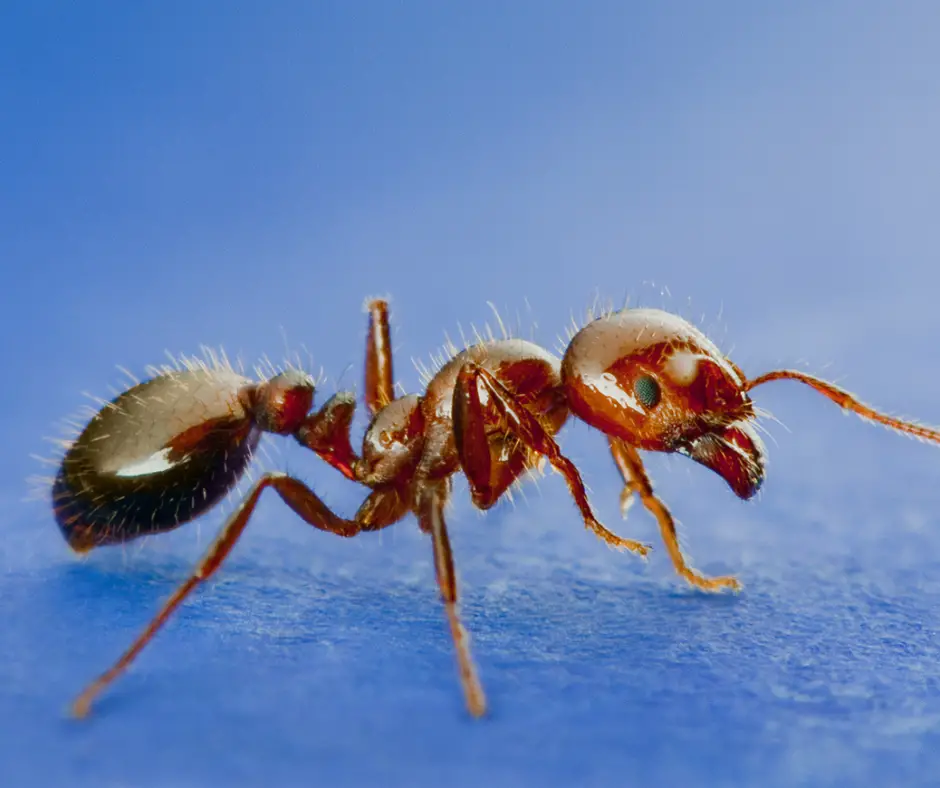
The red imported fire ant (Solenopsis invicta) is a small but highly aggressive ant species that measures around ⅛ to ¼ inch in length. They are reddish-brown with darker abdomens and are easily identified by their fast, coordinated movements and large colony mounds. Though not as widespread in Arizona as in Texas, they are present in the southern regions of the state, particularly in irrigated lawns, gardens, and near water sources.
Fire ants are notorious for their painful stings rather than bites. Each sting injects venom that causes a burning sensation, intense itching, and the formation of white, pus-filled blisters within hours. Multiple stings can result in large areas of redness and swelling. The venom contains alkaloids and piperidine compounds, which can lead to allergic reactions and, in rare cases, anaphylaxis.
These ants are extremely territorial and will swarm aggressively when their mound is disturbed. They latch onto skin with their mandibles and sting repeatedly in a circular pattern, injecting venom with each sting. Children, pets, and individuals with allergies are particularly vulnerable to severe reactions.
Red imported fire ants typically build dome-shaped mounds in soil, especially in moist areas such as lawns, ditches, and riverbanks. They thrive in warm temperatures and prefer environments with regular water access. Controlling infestations can be difficult, as colonies may relocate quickly and rebuild within days.
Sweat Bees
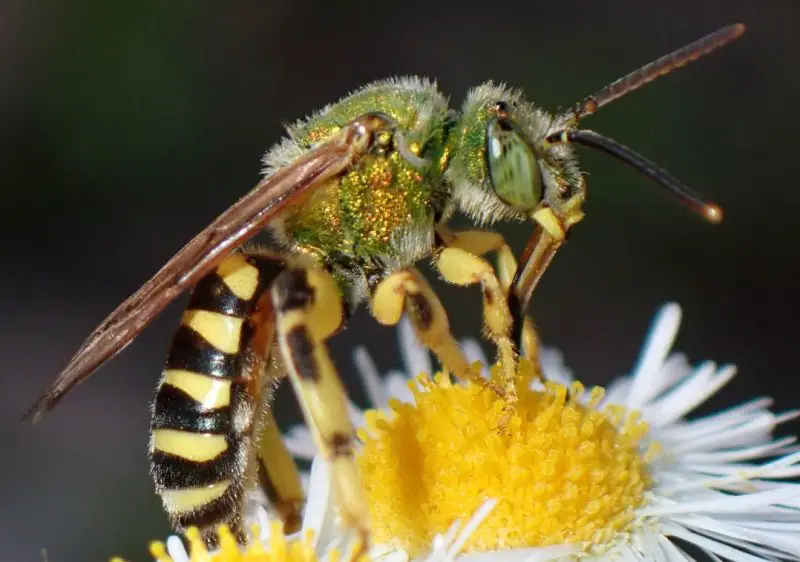
Sweat bees, members of the family Halictidae, are small, metallic-colored bees often measuring less than ½ inch long. Their coloration varies from metallic green or blue to copper or bronze, making them quite distinctive under sunlight. These bees are named for their attraction to human sweat, from which they collect salts and moisture, often landing on exposed skin during warm weather.
Though generally harmless, sweat bees can sting if trapped or brushed away roughly. Their sting is mild, resulting in a sharp prick followed by minor redness, itching, and localized swelling. The venom is weak compared to that of honey bees or wasps, and most people recover quickly without treatment. However, allergic individuals should still exercise caution.
Sweat bees are solitary or semi-social, nesting in the ground or in rotting wood. They are active pollinators and play a crucial role in the reproduction of wildflowers and crops. Females dig small burrows in the soil where they lay eggs and store pollen and nectar for their larvae.
In Arizona, sweat bees are abundant statewide, especially in spring and early summer when wildflowers are in full bloom. They are common in gardens, fields, and desert ecosystems. Because of their docile nature and importance to pollination, they should be left undisturbed if encountered.
Bald-Faced Hornets
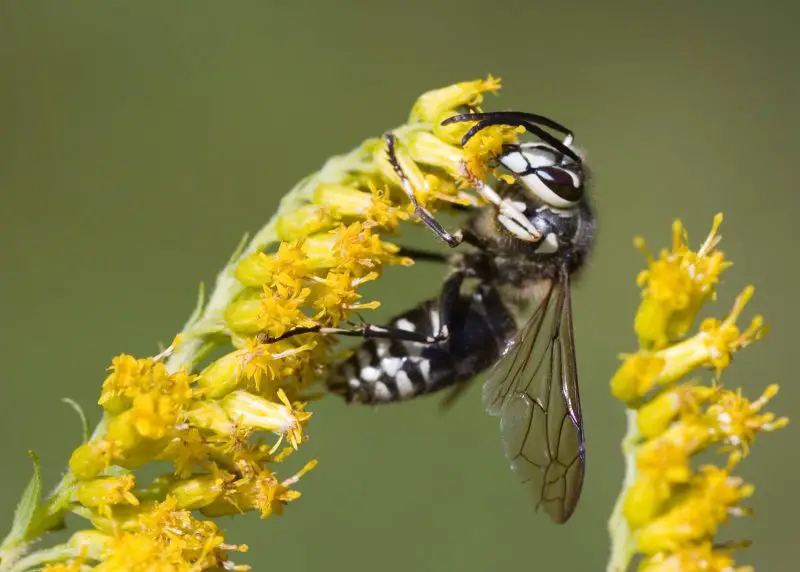
Bald-faced hornets (Dolichovespula maculata) are large, striking insects, typically ¾ to 1 inch long, with black bodies marked by bold white patches on the face and thorax. Despite their name, they are actually a type of yellowjacket, not a true hornet. Their distinctive coloration and large size make them one of the most recognizable wasp species in Arizona.
These hornets are extremely aggressive when defending their nests and can sting repeatedly. Their stings cause severe, burning pain, redness, and significant swelling that may persist for several days. The venom contains acetylcholine and kinins that trigger intense inflammation. People allergic to wasp stings should seek immediate medical attention if stung, as even a single sting can lead to anaphylactic shock.
Bald-faced hornets build large, paper-like nests that are typically spherical and hang high above the ground — in trees, on utility poles, or under eaves. These nests can grow to the size of a basketball and house hundreds of hornets during the summer months. The workers aggressively guard the colony, attacking any perceived threat that ventures too close.
In Arizona, bald-faced hornets are active during the warmer months, especially from late spring to early fall. They prefer wooded areas, suburban yards, and regions with tall vegetation. Because of their defensive nature and painful sting, it’s best to observe them from a safe distance and have professional pest control handle nest removal when necessary.
Solitary Ground Bees
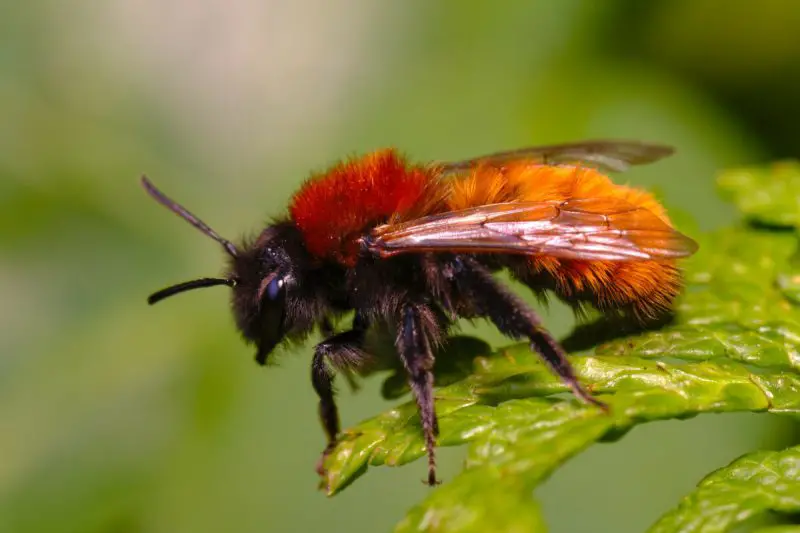
Solitary ground bees are small, gentle bees that nest individually in soft, sandy soil rather than forming large colonies like honey bees. Measuring about ⅜ to ½ inch long, these bees come in shades of brown, black, or metallic green, often with fine hair covering their bodies. Females dig pencil-sized burrows in loose soil, where they construct small chambers to lay eggs and store pollen and nectar for their larvae.
Despite their proximity to humans, solitary ground bees are not aggressive and rarely sting. Their sting is mild—causing only brief pain, redness, or swelling at the site—and they will only defend themselves if stepped on or trapped. Because they nest close together in favorable soil, large clusters can give the false impression of a dangerous swarm, which often alarms people unnecessarily.
These bees play a critical role in pollination, visiting wildflowers and garden plants early in the season. They are most active in early spring, coinciding with the bloom of desert flora. Males are often seen hovering low over the ground in search of females, while females busily dig and maintain nests.
Solitary ground bees are common throughout Arizona’s sandy deserts and suburban areas, particularly around Phoenix and Tucson. They prefer dry, well-drained soils and sunny open spaces, such as gardens, lawns, and desert plains. Since they are beneficial pollinators and pose minimal threat, it’s best to leave them undisturbed.
Puss Caterpillar (Asp Caterpillar)
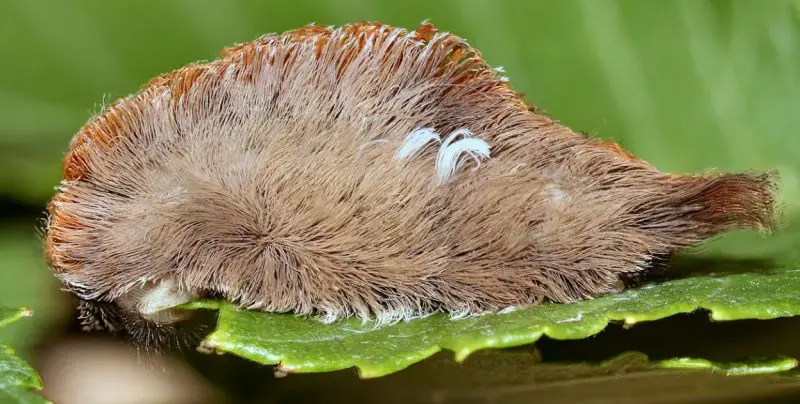
The puss caterpillar (Megalopyge opercularis), also known as the asp caterpillar, is one of the most venomous caterpillars in North America. It is easily recognized by its dense, silky fur that ranges in color from gray to golden brown. Beneath this deceptively soft coat lie venomous spines that can deliver a powerful sting. The caterpillar grows up to 1 inch long and has a rounded, teardrop-shaped body covered in thick, flowing hairs.
When touched, the hidden spines pierce the skin and inject venom that causes immediate, burning pain often compared to a severe bee sting or electric shock. The reaction can spread quickly, leading to swelling, redness, and blistering. In more serious cases, victims may experience nausea, headaches, chest pain, or even fainting. The pain can last for hours, and medical treatment may be necessary for intense reactions.
The adult form of the puss caterpillar is the southern flannel moth, a small fuzzy moth with creamy wings and an orange-yellow body. While the moth itself is harmless, its larval stage poses the danger. These caterpillars feed on leaves of oak, citrus, and other hardwood trees, often blending perfectly with their surroundings.
Though rare in Arizona, puss caterpillars can occasionally appear during the summer months in areas with oak trees, fruit trees, or ornamental shrubs. Their presence is most likely in humid, leafy environments. Avoid handling any fuzzy caterpillar, as many venomous species share similar appearances.
Pepsis Wasp (Giant Spider Wasp)
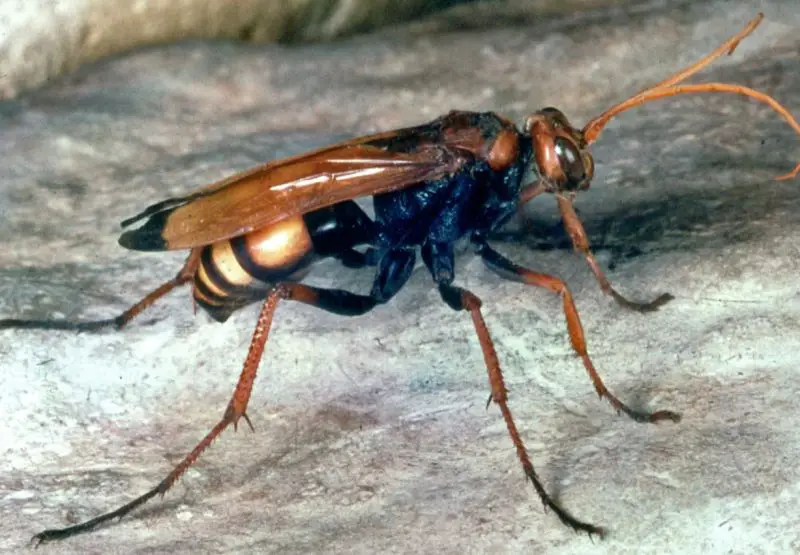
The Pepsis wasp is a massive and striking member of the spider wasp family, closely related to the tarantula hawk. Measuring between 1.5 and 2 inches long, this wasp displays metallic blue or black bodies with bright orange, copper, or iridescent green wings that shimmer in sunlight. Its long legs and agile flight make it one of the most impressive wasps found in the American Southwest.
The sting of a Pepsis wasp is extraordinarily painful, often described as one of the most excruciating stings known to humans. The venom is neurotoxic and designed to paralyze large spiders, particularly tarantulas, which serve as food for its larvae. Fortunately, the pain—though intense—subsides after a few minutes and is not medically dangerous to most people. These wasps are non-aggressive and will only sting if directly handled or severely threatened.
Female Pepsis wasps hunt tarantulas, delivering a single precise sting that paralyzes their prey. The wasp then drags the spider into a burrow and lays an egg on it. Once hatched, the larva feeds on the still-living tarantula. Adult wasps, however, feed exclusively on nectar from desert flowers like milkweed, mesquite, and palo verde.
In Arizona, Pepsis wasps are common throughout the Sonoran and Mojave Deserts. They are most active during hot summer days and can often be seen gliding gracefully through open desert terrain. Despite their terrifying reputation, these wasps are beneficial predators that help maintain ecological balance by controlling spider populations.
FAQs About Dangerous Stinging Insects in Arizona
What are the most dangerous stinging insects in Arizona?
Arizona is home to several dangerous stinging insects, including Africanized honey bees (killer bees), yellowjackets, paper wasps, tarantula hawks, and velvet ants. In addition, Arizona bark scorpions, though not insects, are also notorious for their venomous stings. Each species varies in aggression and venom potency, but all can cause painful stings or allergic reactions when provoked.
How can I identify Africanized honey bees?
Africanized honey bees look almost identical to regular honey bees—about ½ inch long with golden-brown and black striped bodies. The main difference is behavioral: they are far more defensive and aggressive when guarding their hive. If disturbed, they can attack in swarms, chasing victims for long distances.
Are tarantula hawk stings dangerous?
Tarantula hawk stings are considered among the most painful in the world, described as a brief but electrifying pain that lasts several minutes. However, their venom is not medically dangerous to humans unless an allergic reaction occurs. These wasps are generally non-aggressive and sting only if handled or trapped.
What should I do if I get stung by a yellowjacket or hornet?
If stung, immediately move away from the nest area to prevent further attacks. Wash the sting site with soap and water, then apply a cold compress to reduce pain and swelling. Over-the-counter pain relievers or antihistamines can help with discomfort. Seek medical help if you experience difficulty breathing, dizziness, or severe swelling, as these may indicate an allergic reaction.
Are Arizona bark scorpions really that dangerous?
Yes, the Arizona bark scorpion (Centruroides sculpturatus) is the most venomous scorpion in North America. Its sting can cause intense pain, tingling, and temporary paralysis. While deaths are extremely rare thanks to available antivenom, children, pets, and allergic individuals are at greater risk and should receive medical attention immediately after being stung.
How can I avoid being stung by insects in Arizona?
To reduce the risk of stings:
-
Avoid wearing strong perfumes or bright clothing when outdoors.
-
Keep food and drinks covered during picnics.
-
Do not disturb hives, nests, or ground burrows.
-
Seal cracks in walls and roofs where insects may nest.
-
Shake out shoes and clothing before wearing them, especially if stored outdoors.
-
Use caution when gardening, hiking, or working near vegetation or wood piles.
What should I do if I find a wasp or hornet nest near my home?
Do not attempt to remove it yourself. Disturbing a nest can provoke a swarm attack. Contact a licensed pest control professional who can safely handle and remove the nest using proper protective equipment. Early removal during spring, when colonies are smaller, is the safest approach.
Can allergic reactions from insect stings be life-threatening?
Yes. In individuals allergic to insect venom, even one sting can trigger anaphylaxis, a severe, potentially fatal allergic reaction. Symptoms include hives, throat swelling, shortness of breath, rapid heartbeat, and dizziness. Immediate medical attention and the use of an epinephrine auto-injector (EpiPen) can be lifesaving.
Are velvet ants really called “cow killers”?
Yes, the velvet ant earned the nickname “cow killer” because of the intense pain of its sting, though it’s not actually lethal to livestock or humans. This wingless wasp is bright red or orange and uses its venom to defend itself. It rarely stings unless handled or stepped on.
When are stinging insects most active in Arizona?
Most stinging insects in Arizona are active during the spring and summer months, when temperatures are warm and flowers are blooming. Africanized honey bees and wasps become especially aggressive in late summer and early fall as colonies reach their peak size. Scorpions and ground-dwelling insects are most active at night during hot, dry periods.
Do stinging insects serve any ecological purpose?
Yes. Despite their danger, these insects are crucial to Arizona’s ecosystems. Bees and some wasps are essential pollinators for native plants and crops, while predatory wasps and ants help control pest populations. Scorpions also contribute by feeding on insects and other arthropods, maintaining balance in desert food webs.
When should I seek medical help after an insect sting?
Seek immediate medical attention if you experience:
-
Difficulty breathing or swallowing
-
Swelling of the face, tongue, or throat
-
Severe pain that persists or spreads
-
Nausea, vomiting, or dizziness
-
Signs of infection such as pus or fever
For mild stings, home treatment with ice, antihistamines, and rest is usually sufficient. However, anyone with a known allergy to insect venom should treat any sting as an emergency.






